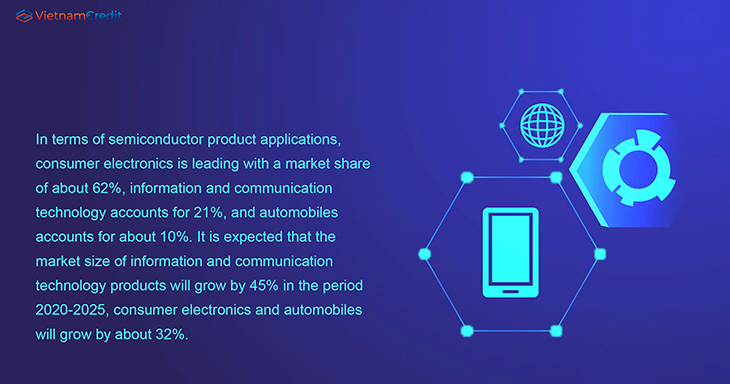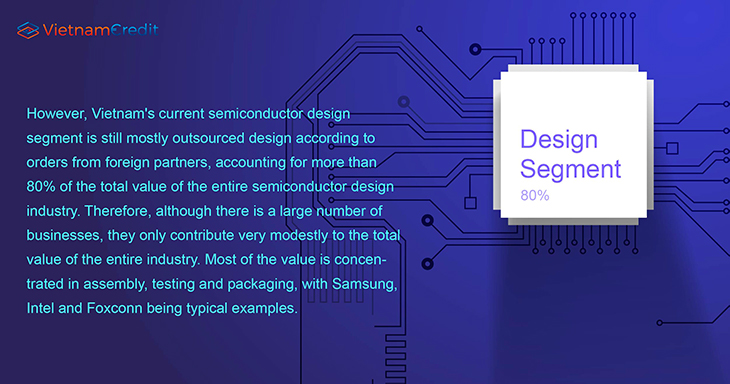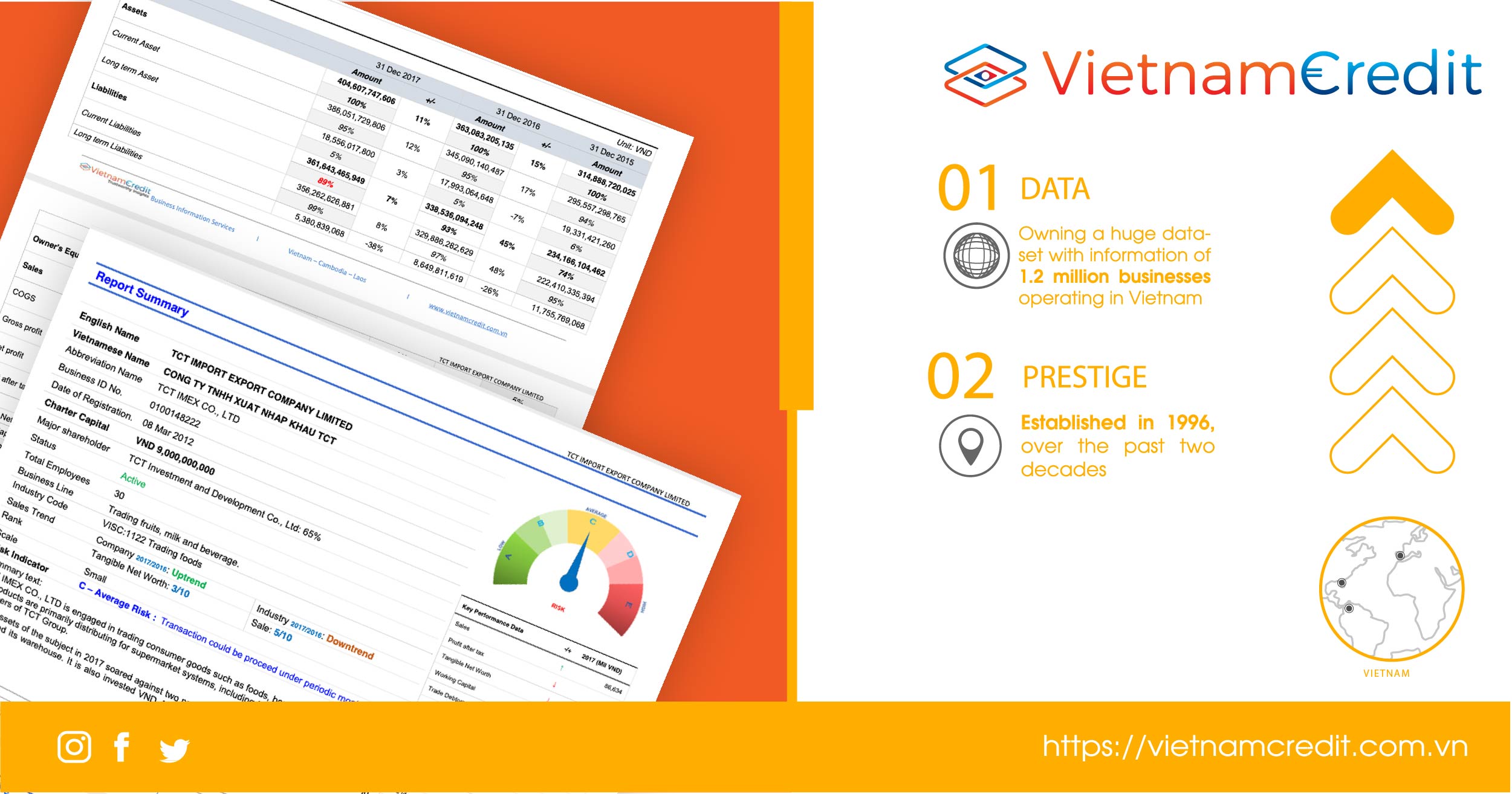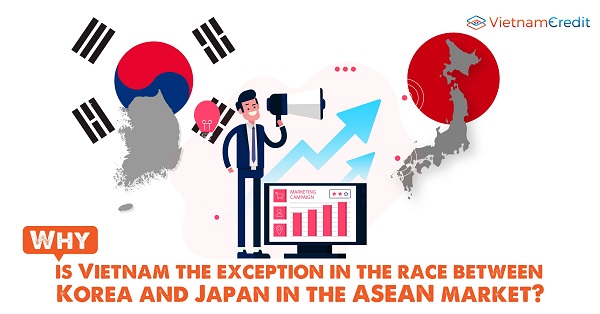Although the semiconductor industry in Vietnam is still in its infancy, there are certain initial achievements in attracting foreign investors, contributing to diversifying the industry value chain.
Growth drivers of the domestic market
In the Vietnamese market, in terms of semiconductor product segments, power management integrated circuits (PMIC) account for the highest market share of nearly 68%, followed by microchips (nearly 29%) and RFID radio wave identification technology. It is estimated that the revenue of the two segments PMIC and microchip will grow by 40% in the period 2020-2025.

In terms of semiconductor product applications, consumer electronics is leading with a market share of about 62%, information and communication technology accounts for 21%, and automobiles accounts for about 10%. It is expected that the market size of information and communication technology products will grow by 45% in the period 2020-2025, consumer electronics and automobiles will grow by about 32%.
Thus, it can be seen that the driving force for the growth of semiconductor products in the Vietnamese market comes from the growth in demand from related technology fields.
Overview of the semiconductor ecosystem in Vietnam
A basic chip manufacturing process includes the following three stages: (1) design, (2) manufacturing and (3) assembly, packaging and testing.
Currently in Vietnam, most businesses in the semiconductor field focus on design (80%), mainly back-end processing. The reason is that this stage does not require large initial investment but only depends on human resources. Furthermore, compared to front-end design, back-end skills are easier to train human resources.

However, Vietnam's current semiconductor design segment is still mostly outsourced design according to orders from foreign partners, accounting for more than 80% of the total value of the entire semiconductor design industry. Therefore, although there is a large number of businesses, they only contribute very modestly to the total value of the entire industry. Most of the value is concentrated in assembly, testing and packaging, with Samsung, Intel and Foxconn being typical examples.
It is believed that given the current situation, the strategic direction for Vietnam is to diversify the semiconductor industry value chain through: (1) enhancing self-reliance to create larger added value in design and assembly, packaging and testing; (2) at the same time creating policy conditions to attract investors to the production segment. However, the first direction is the most feasible, the top priority for Vietnam and also the path that semiconductor technology corporations choose when coming to Vietnam.
Diversifying the value chain is of great significance in perfecting the semiconductor industry ecosystem in Vietnam. The gathering of large foreign corporations will create a spillover effect for the development of supporting businesses. Only then will Vietnam truly mature in this field, proving its ability to undertake most important stages in the production of finished semiconductor chips.
A positive signal in recent years is that many of the world's leading semiconductor corporations such as Samsung, LG, Qualcomm have set up research and development (R&D) headquarters in Vietnam. The upcoming potential will be other research and development centers of Synopsys, Marvell. In addition to the giants in chip assembly and testing that have been present in Vietnam for a long time such as Intel, Foxconn, Amkor also officially started construction of a factory in Bac Ninh last year. These moves will gradually help Vietnam build a diverse industry ecosystem and enhance the value chain.
Challenges in human resources
Facing great opportunities, the Government has promptly grasped the trend and promoted its role through diplomacy and deployment of policy tools to attract investors. However, one of the big worries of investors is the readiness of Vietnamese human resources in the semiconductor field, both in quantity and quality.

Regarding human resources, according to the Minister of Information and Communications Nguyen Manh Hung in a working session with two national universities on September 6, 2023, Vietnam needs 10,000 engineers each year to meet the demand for human resources for the semiconductor industry. But currently only less than 20% is met. In fact, the semiconductor industry has to compete for human resources with other high-tech fields such as electronics, automation, and artificial intelligence which are developing very rapidly.
Regarding the quality of human resources, most universities currently do not have an in-depth training program on IC/semiconductor design, but are mainly based on related industries. The reason is due to the limitation of the team of IC/semiconductor design experts that meet human resources standards at the university and the cost of investing in software systems and laboratories for training.
Source: thesaigontimes
Compiled by VietnamCredit






















































